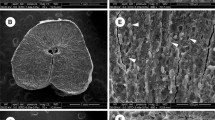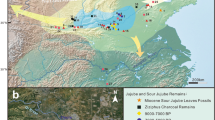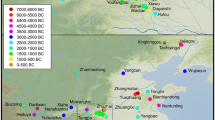Conclusions
A randomly selected sample of 100 kernels from a cache of 644 recovered in a vessel of the Chorrera period was studied to determine what race or races were present. Because 644 kernels could represent 2–3 average-sized ears of Indian maize, more than one type could have been present. Difficulties inherent in analyzing carbonized grain made precise identification to race difficult, but the general shape of the kernels, expressed in width/length and width/thickness ratios, indicates a relationship to a group of races with low row numbers and kernels which are narrow (W/T about 2.0) and very broad (W/L about 1.0). Ecuadorian races such as Morochon, Kcello Ecuatoriano, and Cuzco fit this general configration, but have much larger kernels than the archaeological maize. The cob and ear radii calculated from the archaeological kernels are similar to races such as Andaqui and Kcello (Table 2). These 2 characters are probably the least reliable of the 6 measurements made on the kernels, and have therefore not been emphasized in this study. The race Andaqui of Colombia has grain close to the size of the archaeological maize, but no existing race fits the archaeological maize precisely. The Chorrera maize seems to fall into the same developmental line, or lineage, as the term has been defined by Manglesdorf (1974), as the kernel embedded in the Valdivia vessel from the San Pablo site, identified as Kcello Ecuatoriano (Zevallos et al., 1977).
It is difficult to draw any general conclusions on the development of maize in coastal Ecuador based on the meager data now available. The antecedents of the low row number, broad kernel races are not definitely known, although relationship to the popcorn race Confite Morocho of Peru has been suggested (Manglesdorf, 1974, pp. 113–114). In an examination of the data on all the relic popcorn races of Latin American (Pearsall, 1977/1978), it was proposed that a low row number, round kernel popcorn lineage exists linking the small popcorns of Mesoamerica and northern South America (proto-Nal-tel-Chapalote, Polio group) to those of central Andean South America (Confite Morocho group), and the larger kerneled, low row number flint and flour races evolved from this lineage in many areas, including Ecuador.
Similar content being viewed by others
Literature Cited
Cutler, H. C. 1946. Races of maize in South America. Bot. Mus. Leafl. 12: 257–291.
Cutler, H. C.. 1956. Plant Remains.In Higgins Flat Pueblo Western New Mexico. P. S. Martin, J. B. Rinaldo, E. A. Bluhm, and H. C. Cutler. Fieldiana, Anthropol. Ser. 45: 174–183.
Cutler, H. C., and L. W. Blake. 1973. Corn from Cahokia sites.In Explorations into Cahokia, M. Fowler, ed. Archaeolog. Survey, Bulletin 7, Urbana, Illinois.
Dunn, M. E. 1978. Suggestions for evaluating archaeological maize. Amer. Antiquity 43: 97–99.
Dunn, M. E.. 1979. Ceramic depictions of maize: A basis for classification of prehistoric races. Amer. Antiquity 44: 757–774.
Harlan, J. R., and J. M. J. de Wet. 1973. On the quality of evidence for origin and dispersal of cultivated plants. Curr. Anthrop. 14: 51–62.
Lathrap, D. W. 1975. Ancient Ecuador: Culture, Clay, and Creativity 3000–300B.C. Field Mus. Nat. Hist. Chicago, Illinois.
Manglesdorf, P. C. 1974. Corn, Its Origin, Evolution, and Improvement. Harvard Univ. Press, Cambridge, Massachusetts.
Meggers, B. J. 1966. Ecuador. Praeger, New York.
Pearsall, D. M. 1977/1978. Early movements of maize between Mesoamerica and South America. J. Steward Anthropol. Soc. 9: 41–75.
Pearsall, D. M.. 1978. Phytolith analysis of archaeological soils: Evidence for maize cultivation in Formative Ecuador. Science 199: 177–178.
Pearsall, D. M.. 1979. The Application of Ethnobotanical Techniques to the Problem of Subsistence in the Ecuadorian Formative. Doct. Thesis. Univ. Microfilm, Ann Arbor, Michigan.
Pickersgill, B. 1972. Cultivated plants as evidence for cultural diffusion. Amer. Antiquity 37: 97–104.
Roberts, L. M., U. J. Grant, R. Ramirez E., W. H. Hatheway, D. L. Smith, and P. C. Manglesdorf. 1957. Races of Maize in Colombia. Publication 510. Nat. Acad. Sci.-Nat. Res. Council, Washington, D.C.
Timothy, D. H., B. Pena V., R. Ramirez E., W. L. Brown, and E. Anderson. 1961. Races of Maize in Chile. NAS-NRC Publication 847, Washington, D.C.
-, W. H. Hatheway, U. J. Grant, M. Torregoza, D. Sarria, and D. Varela. 1963. Races of Maize in Ecuador. NAS-NRC Publication 925, Washington, D.C.
Willey, G. R. 1971. An Introduction to American Archaeology. Vol. 2. South America. Prentice- Hall, Englewood Cliffs, New Jersey.
Zevallos M., C., W. C. Galinat, D. W. Lathrap, E. R. Lang, J. G. Marcos, and K. M. Klumpp. 1977. The San Pablo corn kernel and its friends. Science 196: 385–389.
Author information
Authors and Affiliations
Rights and permissions
About this article
Cite this article
Pearsall, D.M. Analysis of an archaeological maize kernel cache from Manabi Province, Ecuador. Econ Bot 34, 344–351 (1980). https://doi.org/10.1007/BF02858308
Received:
Accepted:
Issue Date:
DOI: https://doi.org/10.1007/BF02858308




